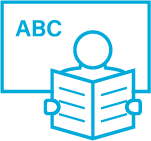Impact of Literacy Interventions on Reading Skills in Low- and Middle-Income Countries: A Meta-Analysis
This study systematically reviewed literacy interventions in low- and middle-income countries, and estimated their effects on children’s reading skills using a meta-analytic approach. The results revealed an overall effect of .30 across various literacy outcomes. The largest effects were identified for emergent literacy skills (.40) and the smallest effects for reading comprehension (.25) and oral language skills (.20).
Authors: Young-Suk G. Kim, Hansol Lee, & Stephanie S. Zuilkowski
Source: Kim, Y.-S. G., Lee, H., & Zuilkowski, S.S. (2020). Impact of Literacy Interventions on Reading Skills in Low- and Middle-Income Countries: A Meta-Analysis. Child Development, 91(2), 638-660, DOI: 10.1111/cdev.13204
This study systematically reviewed literacy interventions in low- and middle-income countries, and estimated their effects on children’s reading skills using a meta-analytic approach. A total of 67 studies met the inclusion criteria. The results revealed an overall effect of .30 across various literacy outcomes. Largest effects were identified for emergent literacy skills (.40) and the smallest effects for reading comprehension (.25) and oral language skills (.20).
- Reading is one of the core foundational skills for academic achievement and careers in the modern information-driven society.
- Beyond individual growth and advancement, reading skills also have economic consequences at the societal level.
- Unfortunately, many children—particularly those in low- and middle-income countries (LMICs)—do not develop foundational reading skills even after years of instruction.
- It is estimated that 9 out of 10 children in Sub-Saharan Africa do not have basic reading skills. A similarly dire situation is also found in Central and Southern Asia.
Key areas of reading instruction
- According to the National Reading Panel, the key areas of reading instruction are phonological awareness, phonics, reading fluency, vocabulary, and reading comprehension.
- Recent studies have revealed that oral language skills beyond vocabulary (such as grammatical knowledge and listening comprehension) as well as higher order cognitive skills (such as inference and perspective taking) are necessary for reading comprehension.
The study
The goal of this study was to review the effects of reading interventions on reading and language outcomes in LMICs using a meta-analytic approach.
Research questions:
- What is the impact of multicomponent literacy intervention in LMICs on language and reading outcomes?
- Do the effects vary as a function of intervention features as well as contextual factors?
Overall, a total of 67 studiesmet all the inclusion criteria, with 129 independent samples representing 661 effect sizes from 32 countries (N = 213,464)
Factors affecting the effect size
- Language in which reading is taught was an issue, as reading acquisition is easier in a child’s most familiar language.
- In some interventions, teachers were provided with a one-off teacher training workshop, whereas in others ongoing support was provided, including regular classroom visits, feedback, and booster training sessions.
- The majority of interventions targeted instruction in the school context only, whereas some incorporated community involvement to encourage literacy-related activities in the children’s homes and communities.
- Interventions also varied in terms of duration and target subjects.
- Results may also have been moderated as a function of contextual features such as urbanicity and region.
Findings
- The effect sizes ranged from -.43 to 2.00.
- A majority (80%) of the effect sizes were positive.
- The overall average effect size was .30.
- The effect sizes were .40 for emergent literacy skills, .32 for word reading, .28 for reading fluency, .25 for reading comprehension, and .20 for oral language.
- The effects of literacy intervention across the outcomes varied as a function of teacher training support, such that interventions with professional development (PD) with ongoing support had a larger average effect than those with one-off PD or no PD.
- For emergent literacy skills, there was larger effect from providing PD and ongoing support in interventions that included ICT that did not involve the community, and which were carried out in Latin America and the Caribbean region.
- For word reading, the average impact of the literacy intervention was greater in the Middle East and North Africa.
- For reading fluency, the effect size was larger with no community involvement in the Middle East and North Africa.
- For reading comprehension, effect sizes were larger if personal development was offered.
- For oral language, using the first language as the medium of literacy interventions was more effective than using a second language. In addition, interventions lasting 1–6 months were more effective than those conducted for <1 month or 6–12 months.
Implications
- Despite the impact of reading development on individual income, health, and empowerment, as well as the economic development of a country, reading has not been taught explicitly as a skill in many LMICs and the majority of children cannot read a single word even after years of instruction.
- The average effect size of .30 is quite impressive and promising.
- With explicit and systematic instruction, lower-level skills (such as emergent literacy skills) are easier to improve (relatively) than higher-order skills such as reading comprehension. Improving reading comprehension requires concerted and sustained efforts to a greater extent compared to constrained skills such as emergent literacy skills.
- One moderator that had a relatively consistent result was teacher training support. The average effect was larger when teachers were either provided with ongoing PD beyond a one-off workshop or had no training.



